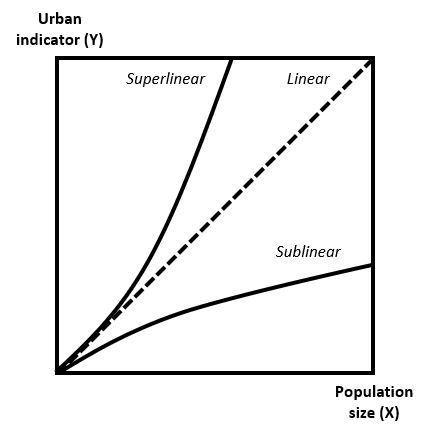
A brief review of scaling concepts and what it means for growth, innovation, and the pace of economic life.
Sublinear and superlinear scales
The last two centuries of rising urbanization and city populations reflect the structural changes in economic makeup, social organization, and human living across the globe. Fascinating, I think, is the phenomenon of cities — the engines of innovation and progress.
It is important then to understand the properties that drive our population centers. Orthodox economics, for instance, has tended to focus on the interplay between capital, labor, and technology, and the consequences of economic and political institutions.
But there is another vantage point, as Bettencourt, Lobo, Helbing, Kühnert and West (BLHK&W) show in their paper Growth, Innovation, Scaling, and the Pace of Life. That is to see societies as complex systems that consist of interwoven networks and institutions, from which scaling patterns arise.
Indeed, BLHK&W find that indicators of economic development and urban systems tend to scale with population size in three predictable ways: linear scaling, sublinear scaling, and superlinear scaling (example below). For instance, we’d expect to find urban indicators to scale linearly with population size in areas that relate closely to individual need. BLHK&W find this to be the case for indicators like household water consumption and employment levels.
Qualitative example of scaling

The economical city
Sublinear scaling, by contrast, tends to arise in indicators that benefit from economies of scale. For instance, we should expect higher population density to generate savings in per capita infrastructure investment. Indeed, BLHK&W find that “doubling the population of any city requires only about an 85 percent increase in infrastructure”. These savings manifest themselves in many way, from the total length of water pipes and electrical cables, to the number of petrol stations. Scaling in this context allows for greater utilization, intensification, and economizing of networks and resources.
The nature of scaling
Indeed, such scale economies are not dissimilar to the resource efficiencies found in nature. Kleiber’s law, for example, shows that organism metabolic rates scales sublinearly with body mass. As BLHK&W explain, “larger organisms consume less energy per unit time and per unit mass”. Size confers “an economy of scale in energy consumption”.
As Geoffrey West explains in his book Scale: The Universal Laws of Life and Death, network principles in biology “have two profound consequences” as distributors of energy and resources in a system: “they constrain the pace of life — big animals live longer, evolve more slowly, and have slower heart rates — and the limits of growth”. Animals will reach a stable size upon maturity as resources are devoted to maintenance and reproduction instead of growth.
“Despite its amazing diversity and complexity, life manifests an extraordinary simplicity and universality in how key structural and dynamical processes scale across a broad spectrum of phenomena and an immense range of energy and mass scales covering 20 orders of magnitude.”
Bettencourt, L., Lobo, J., Helbing, D., Kuhnert, C., & West, G. (2007). Growth, Innovation, Scaling, and the Pace of Life in Cities.
Nonrivalry and increasing returns
Cities, by contrast, are not just economical superorganisms. They are intense networks of “complex changes of people, goods, and knowledge” — “stimulants for economic growth, wealth production, and new ideas”, BLHK&W write. Many urban indicators, like gross domestic product and the rate of new patents, scale superlinearly with population size instead.
Indeed, unlike the lifecycle of an anthill or beehive, the pace of economic life (so far) has been one of haphazard build up, followed by unprecedented take-off. Just contrast, for example, the time and magnitude of change between the Computer Age and Information Age with that of the Stone Age and Iron Age.
While many factors are at work, it’s not hard to see why this is so. A larger population, after all, means more inventors and creators. It also leads to more competition, specialization, and social networking. The result in turn is more innovation, spillover, diffusion, and productivity (aided in part by the nonrivalrous nature of technology).
Put another way, as BLHK&W explain, innovation, wealth creation, and social currencies like knowledge and information tend to exhibit increasing returns to scale; and hence the superlinear scaling relationships we observe with population size. As the authors summarize:
“Three main characteristics vary systematically with population. One, the space required per capita shrinks, thanks to denser settlement and a more intense use of infrastructure. Two, the pace of all socioeconomic activity accelerates, leading to higher productivity. And three, economic and social activities diversify and become more interdependent, resulting in new forms of economic specialization and cultural expression.”
Bettencourt, L., Lobo, J., Helbing, D., Kuhnert, C., & West, G. (2007). Growth, Innovation, Scaling, and the Pace of Life in Cities.
An autocatalytic process
In Guns, Germs, and Steel, Jared Diamond attributes much of human history to a complex interplay of food production, geographic orientation, population growth, cumulative innovations and sheer chance. Human development to Diamond is an “autocatalytic process” — a runaway feedback loop that is difficult to stop once underway. This is not dissimilar to the BLHK&W paper, which focuses on the feedback between scale and increasing returns.
Both viewpoints, however, do not have complete explanatory power. Diamond’s geographic centric framework is less helpful today in a highly globalized, interconnected society. And scaling theory, to my knowledge, does not yet offer cross-system and cross-country explanations.
So to see why some systems grow while others do not, we have to turn to institutional explanations (as in Daren Acemoglu’s Why Nations Fail). Indeed, large cities and enterprises find success not only because of scale. But because the institutional, organizational, and informational networks that underpin their models are scalable in the first place.
Whether we’re talking about companies or nations, scaling poor institutions and networks will lead only to dysfunction. As JBS Haldane writes in On Being the Right Size: “higher animals are not larger than the lower because they are more complicated. They are more complicated because they are larger.” The same, I think, is true of economies and companies too.
Open runways and free lunches
Finally, we should remember that open-ended growth and increasing returns are not free lunches. Earth is small, fragile and finite. While the agricultural, industrial, atomic, and information revolutions allowed us to transcend previous population and economic limits, they’ve also introduced new, graver challenges, from global pandemics and climate change to the spectre of nuclear warfare.
BLHK&W argue that “successive accelerating cycles of faster than exponential growth are consistent with observations for the population of cities, waves of technological change, and the world population”. They also suggest that this too might “generalize to other social organizations, such as corporations… [and explain] why continuous growth necessitates an accelerating treadmill of dynamical cycles of innovation”.
But if the economic pace of life continues to accelerate, might we actually fast track ourselves to collapse? BLHK&W suggest this is plausible unless we continue to find new solutions to current and future existential problems. It seems to me that the ultimate irony and tragedy of the human condition is to graduate from one Malthusian crisis just to face another — a product of the autocatalytic processes and scaling features that spring forth from human nature.
Sources and further reading
- Bettencourt, L., Lobo, J., Helbing, D., Kuhnert, C., & West, G. (2007). Growth, Innovation, Scaling, and the Pace of Life in Cities.
- Bettencourt, L., & West, G. (2010). A Unified Theory of Urban Living.
- Diamond, Jared. (1997). Guns, Germs, and Steel: The Fates of Human Societies
- Kremer, Michael. (1993). Population Growth and Technological Change.
- Haldane, JBS. (1927). On Being the Right Size (In Possible Worlds and Other Essays).
- West, Geoffrey. (2017). Scale: The Universal Laws of Life and Death in Organisms, Cities and Companies.
Recent posts
- What’s Eating the Universe? Paul Davies on Cosmic Eggs and Blundering Atoms
- The Dragons of Eden — Carl Sagan on Limbic Doctrines and Our Bargain with Nature
- The Unexpected Universe — Loren Eiseley on Star Throwers and Incidental Triumphs
- Bridges to Infinity — Michael Guillen on the Boundlessness of Life and Discovery
- Ways of Being — James Bridle on Looking Beyond Human Intelligence
- Predicting the Unpredictable — W J Firth on Chaos and Coexistence
- Order Out of Chaos — Prigogine and Stenger on Our Dialogue With Complexity
- How Brains Think — William Calvin on Intelligence and Darwinian Machines